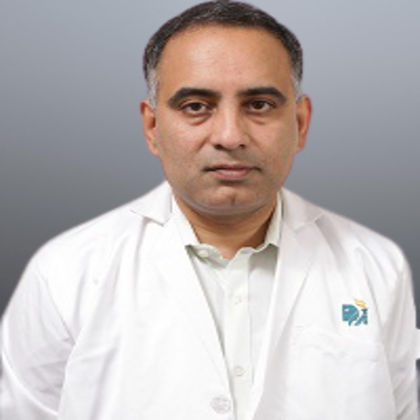Male Breast Cancer
Understanding male breast cancer and its health impacts can guide towards its better management. Let’s explore all about male breast cancer—from signs and symptoms to prevention, treatment and more.

Written by Dr Sonia Bhatt
Last updated on 3rd Jul, 2025
While rare, breast cancer can also affect men since they also have breast tissues. Male breast cancer is often ignored since breast cancer is seen as a “woman’s disease.” This stigma often results in late-stage diagnosis, leading to possible worse results.
Male breast cancer is a rare but serious medical condition. It can have a significant impact, and lack of awareness can potentially lead to delayed diagnosis and unfortunate outcomes. This shows how important it is to spread awareness to promote early detection and timely medical care.
Let’s explore more about male breast cancer towards a better understanding.
Understanding Male Breast Cancer
Male breast cancer occurs when cancer cells develop in the breast tissues of men. Most male breast cancer cases occur in men between 45 to 75 years of age. However, it can occur at any age, so awareness is a necessity.
At the time of diagnosis, compared to women, breast cancer in men often shows more developed features, such as involvement of lymph nodes, larger tumour size, and distant metastases.
Types of Male Breast Cancer
Male breast cancer is categorised into the following types:
Ductal carcinoma in situ (DCIS): A non-invasive male breast cancer where abnormal cells remain within the milk ducts.
Invasive ductal carcinoma (IDC): One of the most common types of male breast cancer that starts in the milk ducts and spreads to nearby tissues.
Inflammatory breast cancer (IBC): A rare, aggressive male breast cancer causing redness, swelling, and warmth in the breast due to lymphatic blockage.
Causes and Risk Factors
Various underlying causes can trigger the onset of breast cancer in males. There’s no one single cause. Let’s explore some of them.
Genetic Factors: A family history of breast cancer may increase the chances of developing male breast cancer due to genetic changes like BRCA1 or BRCA2. It is recommended to consult a healthcare professional if a relative carries these genetic changes. Regular screening is recommended for people with high-risk genes. Screening usually involves checking the chest for lumps and taking annual tests.
Hormonal Influences: Men with a high level of oestrogen are more likely to develop breast cancer. Diseases like obesity and Klinefelter syndrome can cause hormonal imbalances, which raise oestrogen levels, creating a nurturing environment for cancer cells to thrive.
Environmental and Lifestyle Factors: Certain environmental exposures and lifestyle habits may increase the likelihood of developing breast cancer in men. Prolonged exposure to radiation, especially to the chest area, is a known risk factor. Additionally, excessive alcohol consumption and smoking can contribute to cellular damage, raising the likelihood of cancer development.
Signs and Symptoms
As the early signs of male breast cancer are subtle, it is necessary to remain vigilant. Some of the key symptoms include:
A firm, painless lump or thickening in the breast tissue.
Changes in the skin over the breast, like scaling, redness, or dimpling.
Inversion, soreness, or nipple discharge.
The fact that these symptoms can be mistaken for benign conditions showcases how important it is to be vigilant.
Men are advised to consult a doctor if they notice any long-lasting changes in their breast area, especially a lump or skin change. Early medical consultation can help in early diagnosis and positively improve treatment results.
Consult Top Doctors for Your Symptoms
Diagnosis
A thorough consultation and physical examination are the first steps in making a diagnosis. To identify hereditary risks, medical professionals also review obvious changes in addition to reviewing personal and family medical histories.
Some of the common diagnostic tests include:
Imaging tests: A professional uses a mammogram (low-dose x-ray) or MRI to develop pictures of male breast tissues to check for tumours.
Breast exam: A professional examines the breast tissue by checking for lumps or skin changes.
Biopsy: A professional does a biopsy to check for cancer cells in the breast tissues, if a tumour is found, it is sent for lab testing.
Staging and Grading of Male Breast Cancer
The staging methods for breast cancer in men and women are the same.
Stage 0, or Carcinoma in situ, is the earliest breast cancer stage. The latter stages are included through Stage I (1) to Stage IV(4). Stage IV indicates that the cancer has spread considerably.
The TNM system (Tumor size, Node involvement, Metastasis) is the accepted norm for staging male breast cancers. It measures:
The size and area of the main tumour (T)
Whether the tumour has spread to the lymph node (N)
The existence of distant metastasis (M)
Understanding these stages results in more accurate treatment options and better outcome predictions.
Treatment Options
Seamless advancements in the medical field have helped professionals tackle breast cancer in various ways. Here are some of the most common treatment options that can help defeat breast cancer.
Surgery: Most cases of early male breast cancer can be treated with breast cancer surgery. Since men have limited tissues, a mastectomy (removal of the entire breast) is more common than a lumpectomy (removing just the lump).
Radiation Therapy: Medical professionals destroy cancer cells using energy beams like protons or X-rays in radiation therapy. While the patient lies on a table, a machine targets particular locations during the operation. After surgery, it is frequently used to destroy any remaining cancer cells in male breast cancer, usually focusing on the armpit and chest.
Chemotherapy: Chemotherapy uses systemic medication treatment to eliminate cancer cells. It is especially beneficial for advanced-stage tumours or those with a high recurrence rate. Advances in chemotherapy treatments have increased efficacy while lowering negative effects.
Targeted and Hormone Therapies: Hormone therapy is a common treatment for male breast cancer as it helps lower oestrogen levels. Hormone therapy is most common in individuals who have high oestrogen levels, as cancer cells thrive in these conditions. Tamoxifen is one of the most commonly used medications in male breast cancer treatment.
Coping with Male Breast Cancer
A cancer diagnosis can be mentally overwhelming, and since there is so much stigma surrounding breast cancer, men are likely to feel isolated as well. Any support from friends, family, or even a counsellor can offer guidance and encouragement.
In addition to this, making positive lifestyle choices can play a vital role in coping with cancer, such as maintaining a daily routine, exercising, and getting enough rest.
Medical professionals often recommend joining cancer support groups led by professionals or peer-led to create a positive mindset during such tiring times.
Prognosis and Survival Rates
Breast cancer prognosis depends on factors such as overall health, cancer stage at diagnosis, and type of cancer. Early-stage malignancies commonly have better results.
The survival rate in men, although not similar, is comparable to women when diagnosed at the same stage. Recurrence can be prevented with regular follow-ups.
Prevention and Early Detection
Routine health screenings can discover abnormalities early. Men with a family history of breast cancer may consider getting frequent checkups.
Additionally, genetic counselling and testing for mutations like BRCA1 and BRCA2 can provide valuable insights. Men with a family history of breast cancer should consider these options to better understand their risks and take preventive measures.
Conclusion
Male breast cancer, while uncommon, is a serious issue that demands awareness and understanding. Early discovery, timely treatment, and continued support can significantly improve the lives of people affected. Increasing awareness and advocating for preventive measures can help reduce the stigma surrounding male breast cancer and improve outcomes for those affected by the condition.
Consult Top Oncologists
Consult Top Doctors for Your Symptoms

Dr. Tarun Jindal
Uro Oncologist
14 Years • MS (AIIMS, New Delhi), MCh (Gold Medalist), Fellow, VUI, Henry Ford Hospital, Detroit, USA; Robotic and Laparoscopic surgeon
Kolkata
Apollo Multispeciality Hospitals , Kolkata, Kolkata
(100+ Patients)

Dr. Sandeep Muzumder
Radiation Specialist Oncologist
21 Years • MBBS (JIPMER, Pondicherry), MD (AIIMS, New Delhi)
Bhubaneswar
Apollo Hospitals Old Sainik School Road, Bhubaneswar

Dr Nikhil Suresh Ghadyalpatil
Oncologist
18 Years • MBBS, MD (G. Med), DNB (G.Med), MNAMS DM (Medical Oncology - Tata Memorial Hospital) European Certification In Medical Oncology (ECMO) MRCP (Med Onco SCE), PDCR
Hyderabad
Apollo Hospitals Jubilee Hills, Hyderabad

Dr. Raja T
Oncologist
20 Years • MBBS; MD; DM
Chennai
Apollo Hospitals Greams Road, Chennai
(150+ Patients)

Dr. Harsh J Shah
Surgical Oncologist
15 Years • MS, MCh (GI), DrNB (GI)
Ahmedabad
Apollo Hospitals Gandhinagar, Ahmedabad
Consult Top Oncologists

Dr. Tarun Jindal
Uro Oncologist
14 Years • MS (AIIMS, New Delhi), MCh (Gold Medalist), Fellow, VUI, Henry Ford Hospital, Detroit, USA; Robotic and Laparoscopic surgeon
Kolkata
Apollo Multispeciality Hospitals , Kolkata, Kolkata
(100+ Patients)

Dr. Sandeep Muzumder
Radiation Specialist Oncologist
21 Years • MBBS (JIPMER, Pondicherry), MD (AIIMS, New Delhi)
Bhubaneswar
Apollo Hospitals Old Sainik School Road, Bhubaneswar

Dr Nikhil Suresh Ghadyalpatil
Oncologist
18 Years • MBBS, MD (G. Med), DNB (G.Med), MNAMS DM (Medical Oncology - Tata Memorial Hospital) European Certification In Medical Oncology (ECMO) MRCP (Med Onco SCE), PDCR
Hyderabad
Apollo Hospitals Jubilee Hills, Hyderabad

Dr. Raja T
Oncologist
20 Years • MBBS; MD; DM
Chennai
Apollo Hospitals Greams Road, Chennai
(150+ Patients)

Dr. Harsh J Shah
Surgical Oncologist
15 Years • MS, MCh (GI), DrNB (GI)
Ahmedabad
Apollo Hospitals Gandhinagar, Ahmedabad
